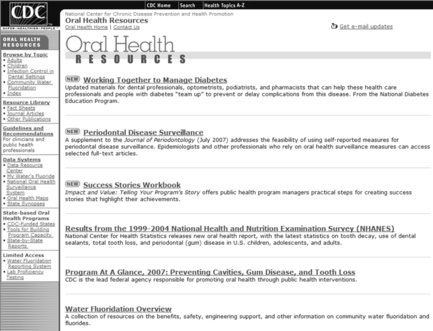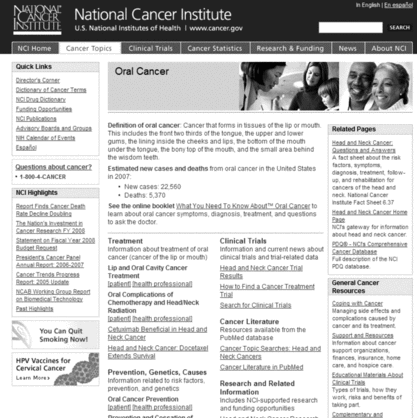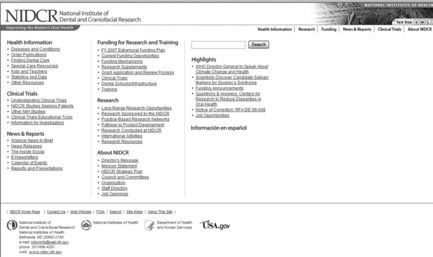ABSTRACT
The publication of Oral Health in America: A Report of the Surgeon General was a hallmark for America's oral health. This first-ever report explained why oral health is essential to an American's health and well-being. Oral health's meaning has evolved from a narrow focus on teeth and gums to recognition of the mouth's critical role in health. As a mirror of the body's overall health, oral health can provide insight and clues about other health conditions. This article describes Web sites that provide information about good oral health practices, prevention, treatment options, clinical trials, special populations, and curriculum resources for teachers.
KEYWORDS:
INTRODUCTION
Beyond a big wide smile, pearly white teeth, and healthy gums lies a mirror to our body's overall health. Oral Health in America: A Report of the Surgeon General, published in May 2000, was the first such report to recognize that oral health is an integral component of an American's life-long health and well-being. The report addressed four themes:
-
Oral health means more than healthy teeth;
-
Oral health is integral to general health;
-
Safe and effective disease prevention measures exist that everyone can adopt to improve oral health and prevent disease; and
-
General health risk factors, such as tobacco use and poor dietary practices, affect oral and craniofacial health.Citation1
The report also extensively discussed health disparities among several vulnerable populations.
Thanks to scientific and technological advances, a better understanding of the relationship between oral health and disease has been realized and as a result, oral health's meaning has been extended beyond a narrow focus on the teeth and gums. It is now understood that oral health encompasses the mouth's relationship to a patient's other health conditions. According to Healthy People 2010's Web site, Healthy People 2010, published November 2000, “provides a framework for prevention for the Nation. It is a statement of national health objectives designed to identify the most significant preventable threats to health and to establish national goals to reduce these threats.”2 Healthy People 2010, Chapter 21, Oral Health, outlines specific goals, issues, and objectives related to oral health.
In May 2003, A National Call to Action to Promote Oral Health detailed tasks to address the issues reported by the Surgeon General in Oral Health in America. Among the recommendations was an increase in oral health literacy, which would provide individuals with the ability to understand oral health information to make informed health care decisions.Citation3 Web sites that provide authoritative, accurate, factual, reliable, relevant, and current consumer oral health information help to meet the oral health literacy goal.
Despite scientific, technological, and information dissemination advances, dental caries are the single most common chronic childhood problem, while periodontal (gum) disease is the most common oral health condition among adults, and the two conditions are the major causes of tooth loss among children and adults, respectively.Citation4 More than 50% of five to nine year olds have had at least one cavity, while periodontal disease affects about 14% of adults aged 45–54 and 23% by ages 65–75. In addition, about 30,000 Americans are diagnosed with oral and pharyngeal cancers annually.Citation3
SELECTED ORAL HEALTH WEB SITES
The sites listed below provide information about various aspects of good oral health practice, prevention, treatment options, clinical trials, and, in some instances, provide curriculum resources for parents and teachers.
Government WebSites Centers for Disease Control and Prevention (CDC). Oral Health Resources <http://www.cdc.gov/OralHealth/>
An agency of the U.S. Department of Health and Human Services, the CDC provides health information and statistics on health and safety topics including diseases and conditions, life stages and populations, and healthy living. The Oral Health Resources section (see Figure ) is subdivided by topic, resource library, guidelines and recommendations, data systems, and state-based oral health programs. The oral health pages can be toggled between English and Spanish as well as several other languages.
FIGURE 1 CDC Oral Health Resources Centers for Disease Control and Prevention. CDC en Español <http://www.cdc.gov/Spanish/>

The site also includes Salud Dental (dental health), entirely in Spanish. The dental health information pages can be toggled between Spanish and English.
Healthfinder.gov <http://www.healthfinder.gov/justforyou/>
This site, sponsored by the Office of Disease Prevention and Health Promotion, contains information selected from government agencies, nonprofit organizations, and universities. Oral health, dental implants, periodontal disease, and tooth decay are included in the Seniors section of the page. The site also includes additional links to news, the health library, consumers guides (includes dentists), kids, and En Español. Users can subscribe by e-mail to receive health news and a monthly newsletter. Healthfinder.gov daily news RSS feed is also available.
Kids.Gov <http://www.kids.gov/>
Kids.gov is the U.S. government's official kids portal. Content is arranged by age (Grades K-5, 6–8, and Educator) and by subject. Oral health and oral hygiene links are listed under the “Health, Fitness, and Safety” subject category. The site is provided by the Federal Citizen Information Center of the Office of Citizen Services, U.S. General Services Association.
MedlinePlus®. Mouth and Teeth <http://www.nlm.nih.gov/medlineplus/mouthandteeth.html>
This searchable site, established and maintained by the National Library of Medicine, includes oral health information among its 740 health topics. Representative topics include gum disease, dentures, piercing and tattooing, and cancer. This site also includes drug information, a medical dictionary and encyclopedia, and health provider directories that include dentists. Other site features include MedlinePlus® in Español and e-mail update and RSS feed registration. MedlinePlus® provides two special formats for low vision users. TMD/TMJ is the only dental related interactive tutorial currently listed.
National Cancer Institute (NCI) Oral Cancer Home Page <http://www.cancer.gov/cancertopics/types/oral/>
The Oral Cancer Home Page (see Figure ) provides access to research-based resources. The page includes definitions, clinical trials, prevention, genetics, causes, screening, research, statistics, and treatment options. There are separate links for patient and health professionals that facilitate selection of consumer-oriented information. The site also includes links to definitions for dental and medical terminology. The quick links to LiveHelp®, a confidential online chat service manned by NCI Information Specialists; the Dictionary of Cancer Terms; and the NCI Drug Dictionary on the side bar enhance the site. Users can also toggle between English and Spanish.
National Institute of Dental and Craniofacial Research (NIDCR) <http://www.nidcr.nih.gov/>
The National Institute of Dental and Craniofacial Research (NIDCR) site (see Figure ) includes dental health and clinical information as well as news and reports. Of particular interest are the links for “Diseases and Conditions” and “Kids and Teachers.” The “Diseases and Conditions” articles include, where appropriate, symptoms, causes, detection, diagnosis, treatment, clinical trials, and news, as well as meeting report and publication links. The “Kids and Teachers” link includes a curriculum supplement, publications, a poster, a webcast link, and a brief list of exhibits and Web sites. Información en Español consists primarily of publications that have been translated into Spanish.
WomensHealth.gov (National Women's Health Information Center (NWHIC)) <http://www.4women.gov/>
This site, under the auspices of the National Women's Health Information Center, is the federal government's source for women's health information. Though “oral health” is not listed in the topic list, users of this site may do a term search to retrieve oral health information relating to women. The site includes a link for Spanish speakers (Recursos en Español).
USA.gov <http://www.usa.gov/>
USA.gov, the U.S. government's official Web portal, provides one-stop access to federal government agencies including the National Cancer Institute and National Institute of Dental and Craniofacial Research. Searching for oral health terms in the site's term search dialog box will retrieve results from across all U.S. government sites. Other information access options include organization, contact government, and specific topics such as health and nutrition. Additional site features include the ability to read the site in Spanish as well as numerous other languages, change display text size, page printing, subscribe to e-mail updates and USA.gov RSS feeds.
Other Web Sites Academy of General Dentistry <http://www.agd.org/>
This professional association site provides a “For the Public” link. Oral health resources in Question and Answer format with a printer-friendly version, oral health PDF fact sheets, 35 dental term definitions, and the ability to ask questions of dentists enhance the usefulness of the site. Oral health topics cover men, women, and children's oral health as well as other specific concerns. The SmileLine link allows consumers to post questions online for Academy member response.
American Academy of Pediatric Dentistry <http://www.aapd.org/>
This site includes the sidebar link “Info for Parents.” FAQs, “Parent Education Brochures,” and “Quick Tips for Busy Parents” provide access to information on children's oral health topics, such as the importance of baby teeth, toothbrush and toothpaste selection, dental sealants, and emergency dental care. Despite the Association's statement of the availability of Spanish versions of four brochures online, they were not located at the time of viewing.
American Academy of Periodontology <http://www.perio.org/consumer/>
The focus of the consumer information on this site is periodontal (gum) disease. The site's split home page screen <http://www.perio.org/> provides “For the Public” links on the left side. In addition, a “Public” tab provides a drop-down menu for oral health information topic selection. Alternatively, the user may choose to perform either a section or site search from the “Oral Health Information for the Public” page. Cause, symptom, treatment, and prevention option information is provided for conditions listed. The site is further enhanced by an online risk assessment survey, patient e-newsletter signup, and a “What's New” section that includes RSS news feeds and featured article links.
American Dental Association. Your Oral Health [and] The ADA Dental Minute <http://www.ada.org/>
“Oral Health Topics A-Z” are included on this site. “ADA Dental Minutes” are concise videos in English and Spanish on a broad range of oral health topics. All of the videos are available in broadband and dialup format. There are also preschool through grade 8 curriculum resources available for teachers.
American Dental Hygienist's Association. Oral Health Information <http://www.adha.org/oralhealth/index.html>
Easy brushing and flossing instructions, discussion of potential problems, oral health tips, tobacco cessation poster downloads, and selected Spanish language materials are included on this site. Many of the consumer resources included on this site are PDF fact sheets from the association. The site also includes questions and answers, games, links to other kid friendly sites, and tooth facts for kids.
Consumer Guide to Dentistry <http://www.yourdentistryguide.com/>
This site, launched in April 2007, “provides consumers with comprehensive, up-to-date, unbiased information on all aspects of dentistry and oral health. The site enlightens consumers about the many dental procedures and products that can enhance their health, their appearance and their lives.” Articles on general oral health written by practitioners, as well as information on dental specialization areas such as cosmetic, orthodontic, and periodontal dentistry, are provided. The articles, some containing illustrations, cover basic information and, when applicable, treatment options. The site also maintains a glossary of dental terms and abbreviations.
Healthy Teeth <http://www.healthyteeth.org/>
Healthy Teeth is a production of the Nova Scotia Dental Association with the assistance of the Canadian Dental Association and the Halifax Dental Society. The award-winning site, which is dentist produced, is an “oral education database built upon the science of oral health and designed for elementary grades 3–6.” Braces, cavities, smoking, sugar, and visiting the dentist are among the topics covered.
Hispanic Dental Association. Resources. Tips for Children (English & Spanish) <http://www.hdassoc.org/>
The Hispanic Dental Association is “dedicated to promoting and improving the oral health of the Hispanic community.” Among the sidebar links that display when Resources is selected are “Tips for Children” (English and Spanish) and “Interesting and Helpful Links.” Information in Spanish is also included on the site.
KidsHealth® (Nemours Foundation) <http://www.kidshealth.org/>
This searchable site provides age-appropriate accurate, up-to-date, jargon-free medical and dental information for parents, kids, and teens. Icons are used to differentiate among the search result for each group. Created and maintained by the Nemours Foundation, the site has received media recognition and won numerous awards, including the Medical Library Association's (MLA) “Top 10 Most Useful Web sites” award in 2002. Among content reviewers are dentists, registered dental hygienists, and physicians.
MayoClinic.com Dental <http://www.mayoclinic.com/>
Dental is one of many health topics included as a subtopic under the “Diseases & Conditions” category. The Dental Home Page features fast links to selected dental topics, as well as links to oral care, oral conditions A-Z, implants, and dentures. Site users may elect to bypass the Dental Home Page and perform a site-wide search. Other site features include registration to receive Mayo's e-newsletter and their RSS feed. The “Health Tools” provide consumers with links to calculator and self-assessment tools for managing health.
New York Online Access to Health (NOAH). Dental Care <http://www.noah-health.org/en/dentistry/index.html>
NOAH, a 2006 MLA Rogers Award winner, provides health care consumers with links to high quality full-text health information in English and Spanish. The site's Health Topic arrangement is alphabetical and further subdivided by care and treatment, children's dental care, specific concerns, and information resources links. Quick links to specific disorders are also provided. Each information link provides the source of the information.
Oral Health America <http://www.oralhealthamerica.org/>
Oral Health America, an advocacy organization founded in 1955, “develops, implements, and facilitates educational and service programs designed to raise awareness of oral health's importance to total health.” Studies in pdf format on various oral health aspects are available for downloading. Topics include patient perspectives, improving children's oral health care, dental work force diversity, and dental care for special populations.
Simple Steps to Better Dental Health® <http://www.simplestepsdental.com/SS/ihtSS/r.WSIHW000/st.31819/t.31819/pr.3.html>
This site, featuring consumer information from Columbia University College of Dental Medicine, focuses on preventing problems, understanding conditions, treatment exploration, and general topics. The site provides links for children, parents, and seniors, as well as interactive tools and illustrations. Dental professionals and site editors decide which topics to include on the site. Each information link provides the source of the information.
CONCLUSION
As these Web sites demonstrate, the Internet provides a wealth of authoritative, accurate, factual, reliable, and current consumer oral health information. Clinical trials, pediatric dentistry, senior oral health, women and other special populations, proper oral hygiene, nutrition, and oral cancer prevention and detection are among the topics represented. Available 24/7, the sites listed in this review are valuable resources for consumers seeking oral health information. Implementation of site enhancements such as e-mail update registration, RSS feeds, and even podcasts, where appropriate, should contribute to furthering the increase of oral health literacy.
Additional information
Notes on contributors
Janice E. Cox
Janice E. Cox, MSLS, MA ([email protected]) is Head Librarian, Dental Library, Indiana University School of Dentistry Library, 1121 West Michigan Street, Room 127-B, Indianapolis, IN 46202.Notes
Comments and suggestions should be sent to the Column Editors: Priscilla Stephenson ([email protected]) and Mary Virginia Taylor ([email protected]).
REFERENCES
- U.S. Department of Health and Human Services . Oral Health in America: A Report of the Surgeon General . Rockville , MD : Department of Health and Human Services, National Institutes of Health, National Institute of Dental and Craniofacial Research , 2000 . Available: <http://www.surgeongeneral.gov/library/oralhealth/>. Accessed: August 23, 2007 .
- U.S. Department of Health and Human Services . Healthy People 2010: Understanding and Improving Health. , 2nd ed. Washington , DC : U.S. Government Printing Office , November 2000 . Available: <http://www.healthypeople.gov/Document/>. Accessed: August 23, 2007 .
- U.S. Department of Health and Human Services . A National Call to Action to Promote Oral Health . Rockville , MD : U.S. Department of Health and Human Services, Public Health Service, National Institutes of Health, National Institute of Dental and Craniofacial Research . NIH Publication No. 03-5303, Spring 2003. Available: <http://www.surgeongeneral.gov/topics/oralhealth/nationalcalltoaction.htm>. Accessed: August 23, 2007 .
- American Dental Hygienists' Association . Dental Hygiene: Focus on Advancing the Profession . Chicago , IL : American Dental Hygienists' Association , 2005 . Available: <http://www.adha.org/downloads/ADHA_Focus_Report.pdf>. Accessed: August 23, 2007 .

